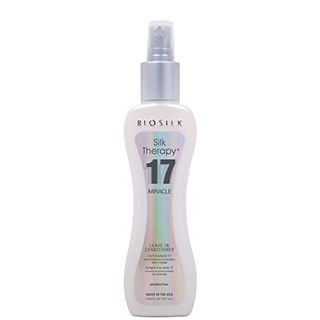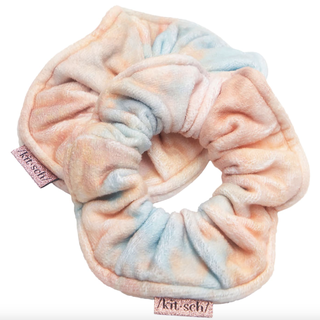Table of Contents
Eventually, somewhere, sometime, probably when you least expect it, the frizz is gonna get you. Maybe it happens on a humid day and all that moisture is rendering your head an untamable, messy mop. Maybe your hair is curly or it’s damaged, and it’s starting to resemble a dandelion gone to seed rather than the sleek, shining locks you’ve always wanted. Whether you’re a redhead like Ree Drummond, have embraced your gorgeous gray hair color, or you’re rocking a different look altogether, you might be left wondering how to get rid of frizzy hair.
That’s why we’ve pulled together a panel of hair experts to answer that very question. It turns out there isn’t a one-size-fits-all way to fight frizz, but instead a ton of tools and methods worth trying.
This content is imported from {embed-name}. You may be able to find the same content in another format, or you may be able to find more information, at their web site.
What is the cause of frizzy hair?
There are many factors that worsen frizzy hair. According to Shelly Aguirre, a stylist at Maxine Salon in Chicago with three decades of hair experience, the main cause of frizzy hair is moisture—either too much or too little of it. “Humidity causes your hair to hold moisture,” Shelly says, “and therefore it gets frizzy.”
It works like this: when there is a lot of moisture in the air (typically, when humidity levels reach more than 70 percent), the water vapors enter the porous hair shaft. It breaks the bond between the hair’s keratin proteins and its hydrogen molecules, which hold the keratin in tight coils. The coils loosen, the hair shaft lengthens and presto: curlier hair becomes frizzy and straighter hair goes limp.
This is why many stylists, including Aguirre, advise using an anti-humectant like Oribe Impermeable Anti-Humidity Spray. “This unique product acts as a finishing spray and a shield against humidity,” she says. “It adds weightless texture, yet has a hold. Perfect product to finish your look!”
Of course, humid weather isn’t the sole culprit here. Frizziness can also be caused a “lack of moisture,” says Allyson Carter, hair stylist and editor-in-chief at the blog Hair Spies. When hair is dry or damaged, the cuticles (which resemble the scales on a pinecone) stand up. Your silky, shiny do suddenly looks a lot like the coif of a well-groomed poodle. It’s a great style for them, not so much for you.
As a remedy, Carter suggests, “a moisturizing shampoo to replenish the scalp.” She continues to say, “I would recommend one with natural ingredients like shea butter, jojoba oil, avocado oil, coconut oil, or cocoa butter.” A product like Oribe Shampoo for Brilliance and Shine, is one that Aguirre says, “will cleanse the hair without weight and adds incredible shine.”
“By helping maintain your hair’s natural oils,” she explains, “you will notice the difference in how your hair behaves day one.”
Why is my hair so frizzy after I wash it?
It’s safe to say that if you’ve been washing your hair every day you’ve been doing it wrong. Soaping up those lovely lock strips them of their natural oils, which is one big reason why you can look like a frizz ball after you get out of the shower and dry your hair.
Instead, follow this recommendation from Katie Graves, senior stylist at Mirror Mirror, a clean beauty salon in Austin, Texas: “Skip a wash or two,” she says. “You do not need to wash your hair every day. Have you ever noticed your hair looks better on day two? Think about it! A little natural oil (aka slightly dirty hair) actually helps weigh the hair down just enough to fight the frizz. I use this tip before a big event. If I have a wedding to go to on Saturday, I wash my hair Friday morning for the best blowout or hairdo that won’t frizz up as much.”
Now that we’ve answered the two biggest questions around frizzy hair, here’s how to get shiny hair.
Sleep in Silk or Satin
Changing your pillowcase seems like such an easy frizz fix you’re probably thinking it can’t possibly really work, right? Wrong.
According to Alex Drummond, who swears by hers, as well as our experts, satin or silk pillowcases not only give you better looking skin by preventing overnight creasing and aiding in the absorption of moisturizers, they also help keep hair frizz-free.
“Curly-haired girls and guys have been using this trick for decades,” Katie adds, “and it really works. Classic cotton pillowcases can rough up your cuticle while you toss and turn and also tend to feel warmer (sweaty neck hair anyone?), which can make your gorgeous blowout frizz up overnight… I like the Kitsch pillowcases,” she adds.
Just Chill
Remember how we noted that one of the best ways to beat back the frizz was to simply wash your hair less often? We didn’t mean that you couldn’t rinse it. You can rinse, and even condition it in between washes—just be sure you’re doing so with cool water. (Hey, it’ll feel good in the summer, right?) It seems that while heat lifts the hair cuticle, helping create frizz, chilly temps have the opposite effect. Rinsing with cool water, says Tiffany Taylor, proprietor of Kansas City’s Another Hairaholic by Tiffany, “will close your hair cuticles and lock in that moisturizer and create less frizz.”
Put a Cap on That
Okay, we admit that they aren’t the most stylish things, but try a shower cap. After all, humidity is usually the enemy of a great coif.
“Confession: When I was a broke college student, I used to tie a grocery bag around my hair and it worked pretty well,” Katie says. “If your budget is higher than that, I recommend ordering a Shhhower Cap. They work great and come in the cutest patterns.”
Trash the Towels
You know those regular old cotton terrycloth towels you’ve been drying yourself with after a shower? Believe it or not, they’ve probably been contributing to your frizz due to their rough texture. “Cotton towels can definitely be harsh on the hair cuticle,” Allyson says, “so if you are noticing a lot of frizz in your hair, try drying it with a microfiber towel or even a soft cotton shirt after your shower.” Also, instead of forcefully rubbing your hair, gently scrunch it up inside the microfiber cloth. It may take longer to dry, but the result will be worth it.
Keep it Cool
We acknowledge it probably won’t be easy, but one of the best ways to reduce frizz is to cut back on your use of styling tools. As noted earlier, damaged hair is frizzy hair, so instead of turning on the blow drier, try blotting your head with your microfiber towel and let air do the rest.
“High heats applied to wet hair are a recipe for frizzy disaster,” notes Marie Burke, Hair & Skin Expert at medical supplier O’Flynn Medical. “These high temperatures can fry the cuticles, leading to that frizzy look—this goes for things like curling tongs and hair straighteners as well as blow driers. Overuse of these devices will ruin your hair! Try and limit blow drier use to around once a week.”
Avoid Alcohol, Sulfates, and Silicones
Check your product labels to make sure everything you’re putting on your head is alcohol-free. Many types of this additive (including propanol, ethanol, isopropyl, and propyl alcohol) will dry out your hair, leading to brittleness, breakage and frizz. Likewise, sulfates strip your hair of its natural oils, causing frizziness.
According to Madison Dufour, author of the hair blog The Exquisite Find and a licensed barber with businesses in Colorado Springs and Atlanta, you should avoid the generic shampoos and conditioners you find in the grocery store. “Most of them use different kinds of silicones (which is plastic), and waxes to coat the hair to make it slick and shiny—at first. But after several washes they build up on the hair and scalp, and that dries the hair and makes it frizzy, too.”
Use the Right Products
There are some types of hair products that our experts say are especially exceptional comes to reducing frizz, like hair spray. Shelly calls it “a great way to control the hair, add body and block out humidity and frizz,” and suggests trying Kerastase Fluidissime Anti Frizz Spray. “It’s a fantastic thermal protectant that will also act as a barrier against humidity,” she adds.”With the conditioning agents that they use to design this incredible product, it will reduce static and frizz immediately!”
Leave-in conditioners are also incredibly popular with our panel. “Definitely use a leave-in conditioner,” Tiffany says. “I can not stress this enough. A lot of people skip it, but it’s good to keep moisture in your hair in between wash days. My favorites are Mizani 25 Miracle Cream for thick and curly hair, and BioSilk Silk Therapy 17 Miracle Leave-In Conditioner for every hair type.”
Avoid Bleach Treatments
Similar to coloring hair, but even worse for it, is bleaching hair. The process can significantly damage the hair cuticles, bringing on the frizz. But if you must do it, you’re going to want to head to a salon. “Generally speaking, at-home bleaching treatments are far more damaging,” Marie says. “In a professional salon, your hairdresser will be combining the bleach with nourishing conditioners and other treatments to keep everything healthy. And they’re also far more adept at spotting early signs of hair damage.”
Keep Trim
It’s sad to say but once hair is broken, it’s broken. Whether you’re looking at a head full of split ends that have traveled up the shaft (eek!) or a halo of fuzzy busted hair (double eek!), the only solution is to cut it. Don’t worry, long-hair lovers! “This does not mean that you have to get all of the length cut,” Dufour promises, “but even just a touch up around the layers can help.”
One word of caution, however: if your stylist tries to trim your curls with either a feather razor or a straight razor, stop ’em in their tracks. “There are many fun techniques to use and try on the hair with razors,” Dufour says, “but when these techniques are used on curly hair, it does not do the same thing and the hair responds poorly, making very big, messy, and frizzy hair.”
Go Professional
While with these tips, and a little diligence, you should be able to keep your hair looking a lot less frizzy all by yourself, sometimes it pays to leave it to the professionals. And we’re not just talking about cuts, either. Salon keratin treatments can produce stronger, softer and even smoother hair. Or, opt for a simple blowout, which is the practice of drying hair into a specific style after a wash, usually with a round brush. The best blowouts can produce shining, sleek hair with no frizz.
“The truth is,” Katie says, “a professional has all the tools, knowledge, and products to get your hair as frizz-free as possible. My hair never looks better than when I first leave the salon!”
This content is created and maintained by a third party, and imported onto this page to help users provide their email addresses. You may be able to find more information about this and similar content at piano.io
https://www.thepioneerwoman.com/beauty/hair/a40128154/how-to-get-rid-frizzy-hair/
 fashion rec fashion wanted
fashion rec fashion wanted








